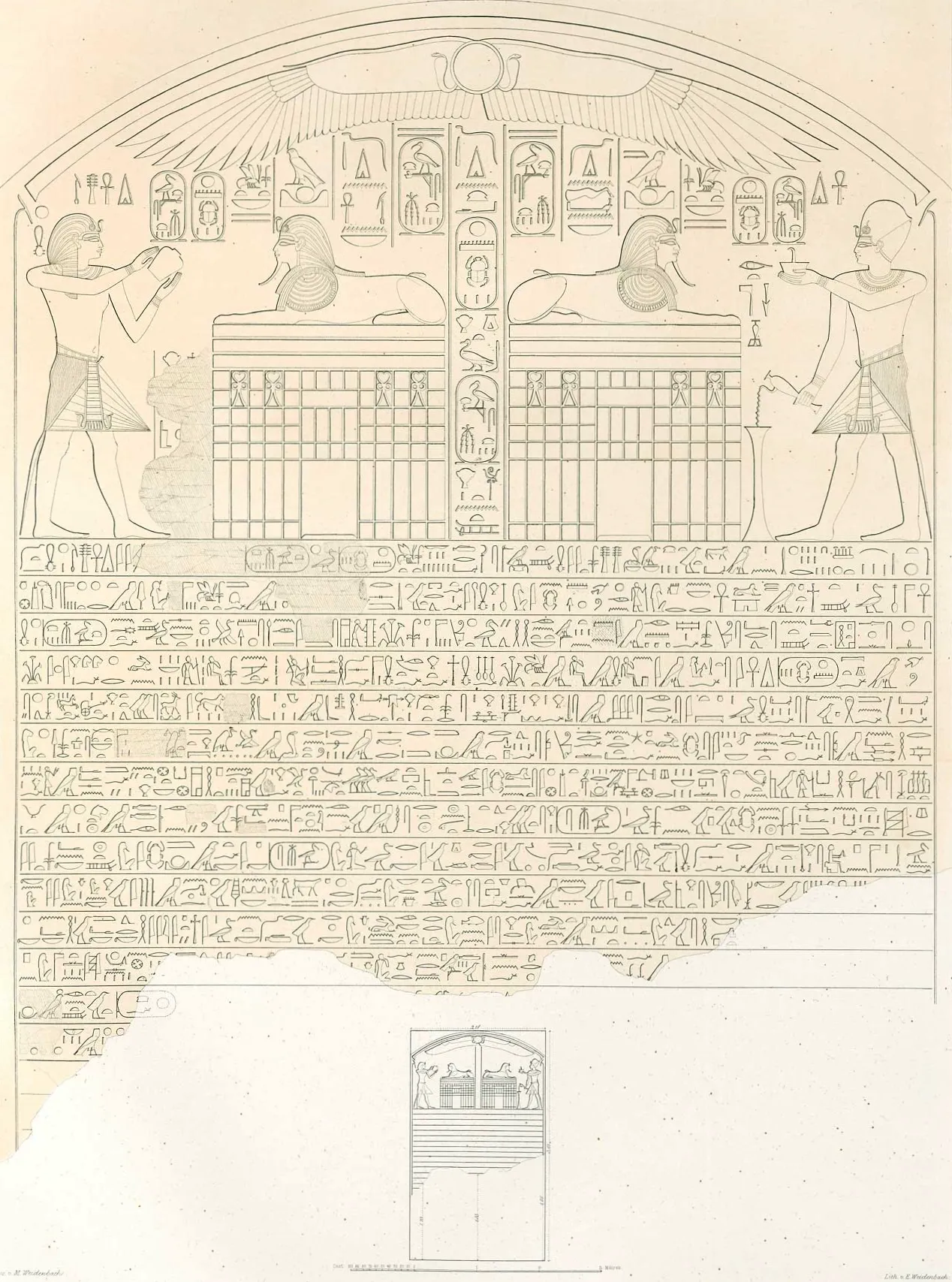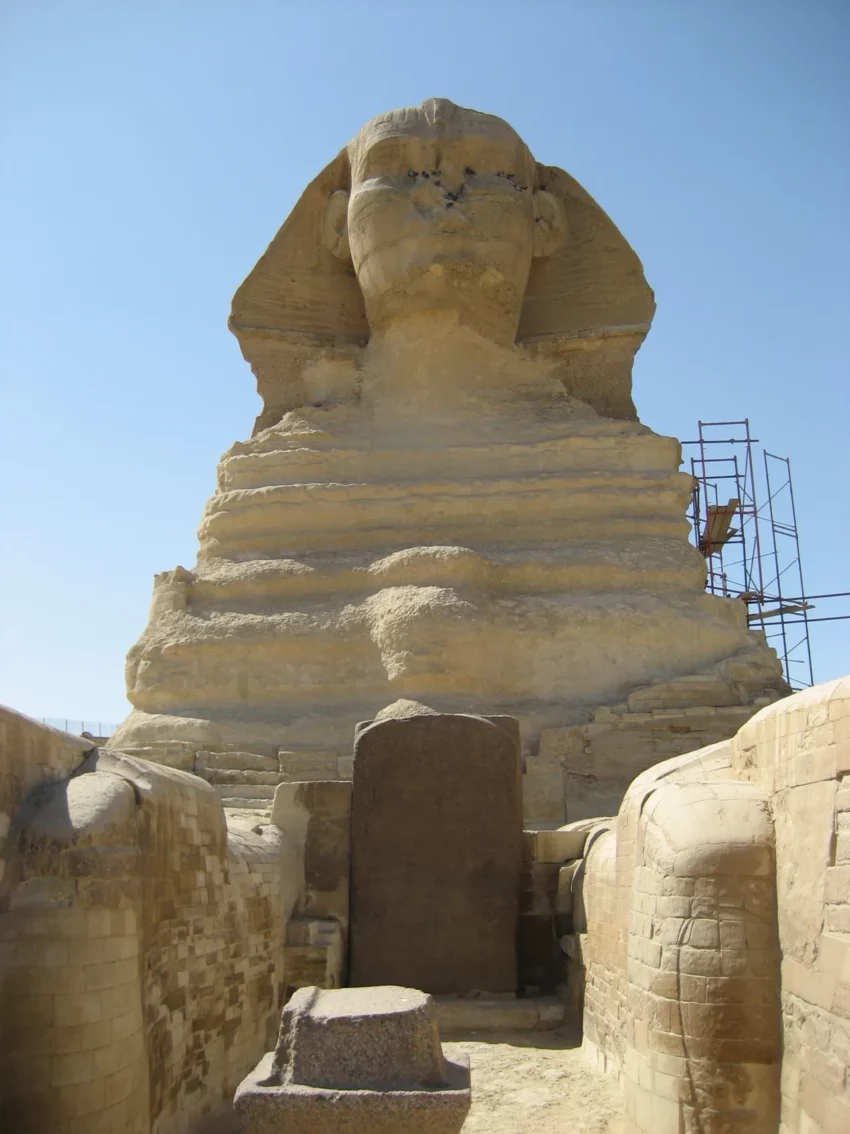Introduction to the Dream Stele
The Dream Stele, also known as the Sphinx Stele, stands prominently between the front paws of the Great Sphinx of Giza. Thutmose IV, a pharaoh of Egypt’s 18th Dynasty, erected this monument in 1401 BC, marking the first year of his reign. This stele is not just a mere artifact; it serves as a divine endorsement of Thutmose IV’s right to rule.
Get your dose of History via Email
Physical Description and Historical Context
Crafted from granite, the Dream Stele measures 3.6 meters in height and weighs approximately 15 tons. Originally, it formed the rear wall of a chapel Thutmose IV constructed in the embrace of the Sphinx. Rediscovered in 1818 by Giovanni Battista Caviglia, the stele’s origins trace back to a door lintel from Khafre’s mortuary temple, evident from matching pivot sockets.
The stele’s lunette depicts Thutmose IV making offerings to the Sphinx, elevated on a pedestal, suggesting the presence of a temple or passageway beneath the Sphinx. This artistic portrayal has fueled ongoing speculation about hidden structures under the Sphinx.

The Text of the Dream Stele
The text on the Dream Stele, though fragmented, reveals much about Thutmose IV’s reign and divine connection. The preserved text praises the pharaoh’s divine right and responsibilities, portraying him as a protector and benefactor of the gods. It details Thutmose’s youthful exploits and his divine encounter during a midday rest under the Sphinx, where he receives promises of kingship and prosperity from the god Hor-em-akhet.
“Year I, third month of the first season, day 19, under the Majesty of Horus, the Mighty Bull, begetting radiance, (the Favourite) of the Two Goddesses, enduring in Kingship like Atum, the Golden Horus, Mighty of Sword, repelling the Nine Bows; the King of Upper and Lower Egypt, Men-kheperu-Ra, the Son of Ra, Thothmes IV, Shining in Diadems; beloved of (Amon), given life, stability and dominion, like Ra, for ever.
Live the Good God, the Son of Atum, Protector of Hor-akhty, Living Image of the All-Lord Sovereign, Begotten of Ra, Excellent Heir of Kheperi, beautiful of face like his father, who came forth equipped with the form of Horus upon him, a King who… favour with the Ennead of the Gods; who purifies Heliopolis, who satisfies Ra; who beautifies Memphis, who presents Truth to Atum, who offers it to Him who is South of his Wall (Ptah), who makes a monument by daily offering to the God who created all things, seeking benefits for the Gods of the South and the North, who builds their houses of limestone, who endows all their offerings, Son of Atum of His Body, Thothmes IV, Shining in Diadems like Ra, Heir of Horus upon His Throne, Men-kheperu-Ra, given life.
When His Majesty was a stripling, like Horus, the Youth in Khemmis, his beauty was like the Protector of His Father, he seemed like the God himself. The army rejoiced because of love for him, and he repeated the circuit of his might like the Son of Nut and all the princes and all the great ones…
Behold, he did a thing which gave him pleasure upon the highlands of the Memphite Nome, upon its southern and northern road shooting at a target with copper bolts, hunting lions and the small game of the desert, coursing in his chariot, his horses being swifter than the wind, together with two of his followers, while not a soul knew it.
Now, when his hour came for giving rest to his followers, it was always at the Setepet (Sanctuary of Hor-em-akhet), beside Seker in Rostaw, Rennutet in Iat-Ta-Mut(?)… in the desert (or necropolis), Mut of the Southern… (Neit?), Mistress of the Southern Wall. Sekhmet, presiding over the Mountain, the Splendid Place of the Beginning of Time, opposite the Lords of Kher-ahah (Babylon), the sacred road of the Gods to the Western Necropolis of Iwn (Heliopolis).
Now, the very great statue of Kheperi rests in this place the great in power, the splendid in strength, upon which the shadow of Ra tarries. The quarters of Memphis, and all the cities which are by him come to him, raising their hands for him in praise to his face, bearing oblations for his Ka.
One of those days it came to pass that the King’s Son Thothmes came, coursing at the time of mid-day, and he rested in the shadow of this Great God. Sleep seized him at the hour when the sun was in its zenith, and he found the Majesty of this Revered God speaking with his own mouth, as a father speaks with his son, saying: ‘Behold thou me, my son, Thothmes. I am thy father, Hor-em-akhet-Kheperi-Ra-Atum; I will give to thee my Kingdom upon earth at the head of the living. Thou shalt wear the White Crown and the Red Crown upon the Throne of Geb, the Hereditary Prince. The land shall be thine, in its length and in its breath, that which the eye of the All-Lord shines upon. The food of the Two Lands shall be thine, the great tribute of all countries, the duration of a long period of years. My face is directed to you, my heart is to you; Thou shalt be to me the protector of my affairs, because I am ailing in all my limbs. The sands of the Sanctuary, upon which I am, have reached me; turn to me in order to do what I desire. I know that thou art my son, my protector; behold; I am with thee, I am thy leader.’
When he finished this speech, the King’s Son awoke, hearing this…, he understood the words of the God, and he put them in his heart. He said: ‘Come, let us hasten to our houses in the city; they shall protect the oblations for this God which we bring for him (or that we shall protect… and that we may bring): oxen… and all young vegetables; and we shall give praise to Wennefer… Khafra, the statue made for Atum-Hor-em-akhet…”
Interpretations and Theories
The narrative of Thutmose being chosen by the Sphinx to rule raises questions about his path to the throne. Some speculate that Thutmose was not the original heir, suggesting he might have usurped the throne from his brothers. This theory is supported by the discovery of other stelae with erased names, possibly belonging to Thutmose’s brothers, indicating a potential elimination of rivals.
Medical Insights from the Stele
In 2012, Dr. Hutan Ashrafian proposed that Thutmose IV’s premature death, along with other 18th Dynasty pharaohs, could be attributed to familial temporal epilepsy. This condition might explain the intense spiritual visions described on the Dream Stele, linking medical science with historical and religious narratives.
Conclusion
The Dream Stele of Thutmose IV is a complex artifact that offers insights into ancient Egyptian politics, religion, and art. It not only commemorates a pharaoh’s reign but also serves as a focal point for historical and medical speculation. This stele remains a crucial piece in understanding the life and times of Thutmose IV and the broader cultural practices of ancient Egypt.

